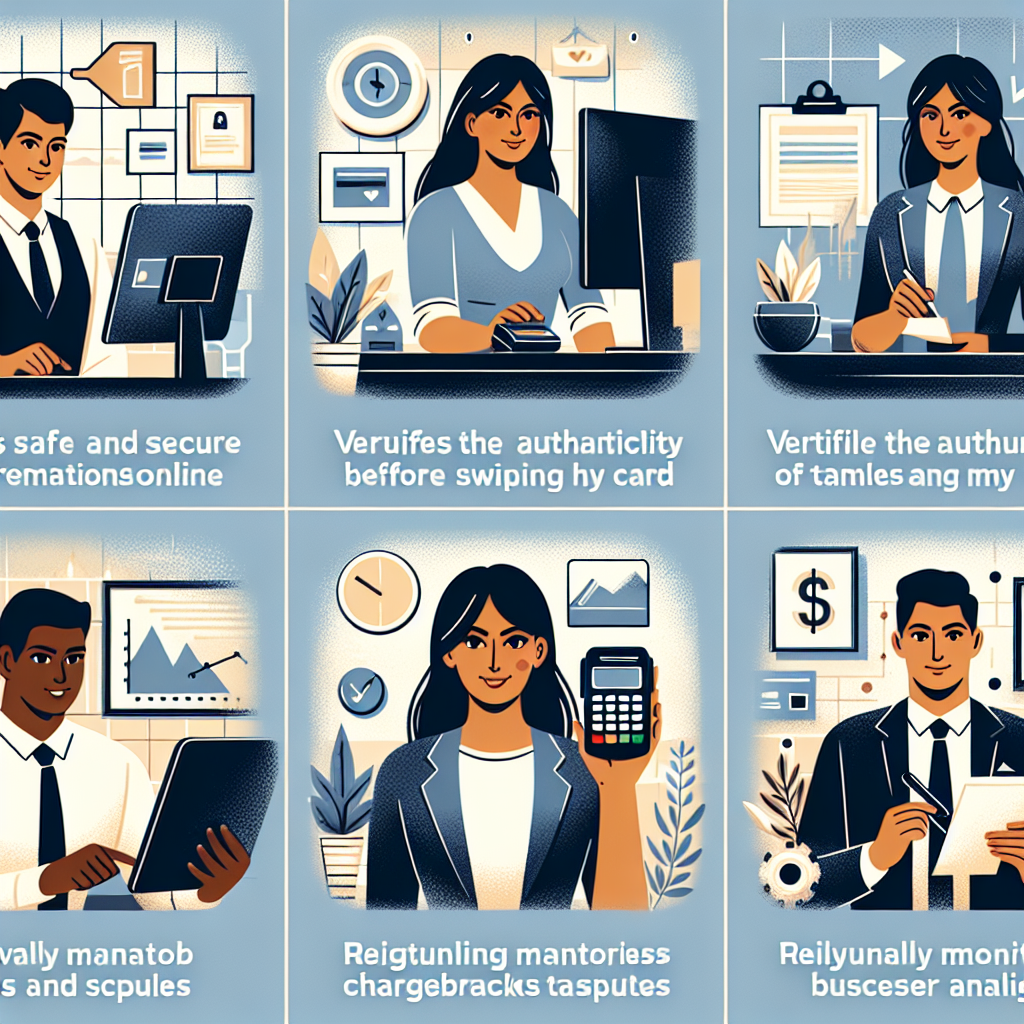-
Table of Contents
- Understanding the Basics of Credit Card Processing
- Choosing the Right Credit Card Processor for Your Business
- Implementing Effective Security Measures for Credit Card Transactions
- Optimizing the Checkout Process for a Seamless Customer Experience
- Avoiding Common Pitfalls in Credit Card Processing to Ensure Smooth Transactions
- Q&A
Understanding the Basics of Credit Card Processing
Understanding the Basics of Credit Card Processing
In today’s digital age, credit card processing has become an essential part of running a business. Whether you own a small retail store or an online e-commerce platform, accepting credit card payments is crucial for seamless transactions. However, navigating the world of credit card processing can be overwhelming, especially for those new to the industry. To help you make the most of this payment method, we have compiled the top five credit card processing tips for seamless transactions.
First and foremost, it is essential to understand the basics of credit card processing. When a customer makes a purchase using their credit card, the transaction goes through a series of steps before the funds are transferred to your business account. These steps include authorization, batching, and settlement. Authorization is the process of verifying whether the customer has sufficient funds to complete the transaction. Batching involves collecting all the authorized transactions throughout the day and sending them for settlement. Settlement is the final step where the funds are transferred from the customer’s account to your business account.
Now that you have a basic understanding of credit card processing, let’s move on to our first tip: choosing the right payment processor. With so many options available, it is crucial to research and select a payment processor that meets your business needs. Look for a processor that offers competitive rates, excellent customer service, and robust security features. Additionally, consider the types of payments they accept, such as mobile payments or online payments, to ensure they align with your business model.
Once you have chosen a payment processor, our second tip is to prioritize security. Credit card fraud is a significant concern for both businesses and customers. To protect your customers’ sensitive information and your business reputation, ensure that your payment processor complies with Payment Card Industry Data Security Standard (PCI DSS) requirements. This standard sets guidelines for securely handling credit card information and helps prevent data breaches.
Moving on to our third tip, it is crucial to optimize your checkout process. A lengthy and complicated checkout process can lead to cart abandonment and lost sales. Streamline your checkout process by minimizing the number of steps required to complete a purchase. Offer guest checkout options and provide clear instructions for entering credit card information. Additionally, consider implementing features such as auto-fill to make the process even more seamless for your customers.
Our fourth tip is to stay up to date with industry trends and technology. The world of credit card processing is constantly evolving, with new payment methods and technologies emerging regularly. Stay informed about the latest trends and consider adopting new technologies that can enhance your customers’ payment experience. For example, contactless payments and mobile wallets are gaining popularity, so it may be worth exploring these options to stay ahead of the curve.
Lastly, our fifth tip is to regularly review your processing statements and fees. It is essential to understand the fees associated with credit card processing and ensure they align with your business’s financial goals. Review your processing statements regularly to identify any hidden fees or unnecessary charges. If you notice any discrepancies, don’t hesitate to reach out to your payment processor for clarification.
In conclusion, credit card processing is a vital aspect of running a business in today’s digital world. By understanding the basics of credit card processing and following these top five tips, you can ensure seamless transactions for your customers. Choose the right payment processor, prioritize security, optimize your checkout process, stay up to date with industry trends, and regularly review your processing statements and fees. With these tips in mind, you can navigate the world of credit card processing with confidence and provide a seamless payment experience for your customers.
Choosing the Right Credit Card Processor for Your Business
Choosing the Right Credit Card Processor for Your Business
In today’s digital age, accepting credit card payments is essential for any business. It not only provides convenience for customers but also opens up new opportunities for growth and increased revenue. However, with so many credit card processors available in the market, it can be overwhelming to choose the right one for your business. To help you make an informed decision, we have compiled the top five credit card processing tips for seamless transactions.
Firstly, it is crucial to consider the fees associated with credit card processing. Different processors have varying fee structures, including transaction fees, monthly fees, and chargeback fees. It is essential to understand these fees and compare them across different processors to ensure you are getting the best deal for your business. Additionally, be wary of any hidden fees that may not be immediately apparent. Transparency in fee structures is a key factor to consider when choosing a credit card processor.
Secondly, security should be a top priority when selecting a credit card processor. With the increasing number of data breaches and cyber threats, it is crucial to choose a processor that prioritizes the security of your customers’ sensitive information. Look for processors that offer encryption and tokenization to protect cardholder data. Additionally, ensure that the processor is compliant with Payment Card Industry Data Security Standard (PCI DSS) requirements. By choosing a secure credit card processor, you can instill trust in your customers and protect your business from potential liabilities.
Next, consider the integration options offered by the credit card processor. Seamless integration with your existing point-of-sale (POS) system or e-commerce platform is essential for a smooth transaction process. Look for processors that offer easy integration with popular POS systems and e-commerce platforms. This will not only save you time and effort but also provide a seamless experience for your customers. Additionally, consider the availability of mobile payment options, as more customers are now using their smartphones to make purchases.
Another important factor to consider is the customer support provided by the credit card processor. In the event of any issues or technical difficulties, having reliable customer support can make a significant difference in resolving problems quickly and efficiently. Look for processors that offer 24/7 customer support through multiple channels, such as phone, email, and live chat. Additionally, read reviews and testimonials to gauge the quality of customer support provided by the processor.
Lastly, consider the scalability and flexibility offered by the credit card processor. As your business grows, you may need to process a higher volume of transactions or expand into new markets. Choosing a processor that can accommodate your future needs is essential to avoid any disruptions in your business operations. Look for processors that offer scalable solutions and have the capability to handle increased transaction volumes. Additionally, consider processors that offer multi-currency support if you plan to expand internationally.
In conclusion, choosing the right credit card processor for your business is a crucial decision that can impact your customer experience, security, and overall business operations. By considering the fees, security, integration options, customer support, and scalability offered by different processors, you can make an informed decision that ensures seamless transactions for your business. Remember to thoroughly research and compare different processors before making a final decision.
Implementing Effective Security Measures for Credit Card Transactions

Implementing Effective Security Measures for Credit Card Transactions
In today’s digital age, credit card transactions have become an integral part of our daily lives. Whether it’s shopping online or paying for goods and services in person, credit cards offer convenience and ease of use. However, with the rise in cybercrime and data breaches, it is crucial for businesses to implement effective security measures to protect their customers’ credit card information. Here are the top 5 credit card processing tips for seamless transactions.
First and foremost, businesses should ensure that they are using a secure payment gateway. A payment gateway is a software application that securely authorizes credit card payments and transfers funds between the customer’s bank account and the merchant’s account. It acts as a middleman between the customer, the merchant, and the credit card network. By using a secure payment gateway, businesses can encrypt sensitive credit card information, making it virtually impossible for hackers to intercept and steal the data.
Secondly, it is essential to comply with the Payment Card Industry Data Security Standard (PCI DSS). The PCI DSS is a set of security standards designed to protect credit card data during and after a transaction. It includes requirements for secure network architecture, encryption, access control, and regular monitoring and testing of security systems. By complying with these standards, businesses can ensure that they are taking the necessary steps to safeguard their customers’ credit card information.
Another important tip is to implement tokenization. Tokenization is a process that replaces sensitive credit card information with a unique identifier called a token. This token can be used for future transactions, eliminating the need to store actual credit card data. By implementing tokenization, businesses can significantly reduce the risk of data breaches since even if a hacker gains access to the token, it is useless without the corresponding credit card information.
Furthermore, businesses should regularly update their software and systems to protect against vulnerabilities. Hackers are constantly evolving their techniques, and outdated software can be an easy target for cyberattacks. By regularly updating their systems, businesses can ensure that they have the latest security patches and fixes, making it harder for hackers to exploit any vulnerabilities.
Lastly, businesses should educate their employees and customers about the importance of security measures. Employees should be trained on how to handle credit card information securely, including the proper disposal of physical receipts and the use of strong passwords. Customers should also be informed about the security measures in place and how their credit card information is being protected. By raising awareness and promoting a culture of security, businesses can further enhance the trust and confidence of their customers.
In conclusion, implementing effective security measures for credit card transactions is crucial in today’s digital landscape. By using a secure payment gateway, complying with PCI DSS, implementing tokenization, regularly updating software, and educating employees and customers, businesses can ensure seamless and secure credit card transactions. These tips not only protect businesses from potential data breaches but also build trust and loyalty among customers, ultimately leading to long-term success.
Optimizing the Checkout Process for a Seamless Customer Experience
In today’s fast-paced digital world, providing a seamless customer experience is crucial for businesses to thrive. One area that often gets overlooked but plays a significant role in customer satisfaction is the checkout process. A smooth and efficient credit card processing system can make all the difference in ensuring a seamless transaction for your customers. Here are the top five credit card processing tips to optimize your checkout process and enhance the overall customer experience.
First and foremost, it is essential to choose a reliable credit card processing provider. Look for a reputable company that offers secure and efficient payment solutions. A reliable provider will ensure that your customers’ payment information is protected and that transactions are processed quickly and accurately. Conduct thorough research and read reviews to find a provider that best suits your business needs.
Secondly, consider implementing a mobile payment option. With the increasing popularity of smartphones, many customers prefer to make purchases using their mobile devices. By offering a mobile payment option, you can cater to this growing customer segment and provide them with a convenient and seamless checkout experience. Mobile payment solutions also allow for faster transactions, reducing wait times and improving overall customer satisfaction.
Another crucial tip is to optimize your website for a smooth checkout process. Ensure that your website is user-friendly and easy to navigate. Streamline the checkout process by minimizing the number of steps required to complete a purchase. Implementing an auto-fill feature for customer information can also save time and reduce the chances of errors during the checkout process. Additionally, make sure that your website is mobile-responsive, as many customers prefer to shop on their smartphones or tablets.
Furthermore, it is essential to be transparent about your payment policies and fees. Clearly communicate any additional charges, such as shipping fees or taxes, upfront to avoid any surprises for your customers during the checkout process. Providing this information in a clear and concise manner will help build trust with your customers and prevent any potential frustrations or misunderstandings.
Lastly, regularly monitor and analyze your credit card processing data. By keeping a close eye on your transaction data, you can identify any issues or bottlenecks in the checkout process. Look for patterns or trends that may indicate areas for improvement. For example, if you notice a high rate of abandoned carts, it may be a sign that your checkout process is too complicated or time-consuming. Use this data to make informed decisions and implement changes that will enhance the overall customer experience.
In conclusion, optimizing the checkout process is crucial for providing a seamless customer experience. By following these top five credit card processing tips, you can ensure that your customers have a smooth and efficient checkout experience. Choose a reliable credit card processing provider, offer a mobile payment option, optimize your website, be transparent about payment policies, and regularly monitor your transaction data. By implementing these strategies, you can enhance customer satisfaction, increase sales, and build a loyal customer base.
Avoiding Common Pitfalls in Credit Card Processing to Ensure Smooth Transactions
Credit card processing is an essential aspect of any business that accepts electronic payments. However, it can sometimes be a complex and challenging process, leading to potential pitfalls that can disrupt the smooth flow of transactions. To ensure seamless transactions and avoid common pitfalls in credit card processing, businesses need to follow a set of best practices. In this article, we will discuss the top five credit card processing tips that can help businesses navigate this process smoothly.
First and foremost, it is crucial to choose a reliable and reputable credit card processor. With numerous options available in the market, businesses must conduct thorough research and select a processor that aligns with their specific needs. Look for a processor that offers competitive rates, excellent customer service, and robust security measures. A reliable processor will not only ensure smooth transactions but also provide support in case of any issues or disputes.
Secondly, businesses should prioritize security when it comes to credit card processing. Data breaches and fraud are significant concerns in today’s digital landscape. To protect sensitive customer information, businesses must comply with Payment Card Industry Data Security Standard (PCI DSS) requirements. This includes implementing secure payment gateways, encrypting data, and regularly monitoring and updating security measures. By prioritizing security, businesses can build trust with their customers and minimize the risk of fraudulent activities.
Another important tip is to optimize the checkout process for a seamless experience. Lengthy and complicated checkout processes can frustrate customers and lead to abandoned transactions. To avoid this, businesses should streamline their checkout process by minimizing the number of steps required and offering multiple payment options. Additionally, providing clear instructions and error messages can help customers navigate the process smoothly and reduce the likelihood of errors.
Next, businesses should regularly review and reconcile their credit card processing statements. It is essential to carefully examine each statement to ensure accuracy and identify any discrepancies or unauthorized charges. By promptly addressing any issues, businesses can avoid potential financial losses and maintain a healthy financial record. Regular reconciliation also helps in identifying patterns or trends that can provide valuable insights for improving the overall credit card processing system.
Lastly, businesses should stay updated with the latest industry trends and regulations. The credit card processing landscape is constantly evolving, with new technologies and regulations being introduced regularly. By staying informed, businesses can adapt to these changes and ensure compliance with industry standards. This includes keeping up with new payment technologies, such as mobile wallets or contactless payments, and understanding any changes in regulations that may impact credit card processing.
In conclusion, credit card processing is a critical aspect of any business, and avoiding common pitfalls is essential for ensuring seamless transactions. By following these top five credit card processing tips, businesses can choose a reliable processor, prioritize security, optimize the checkout process, review statements regularly, and stay updated with industry trends. Implementing these best practices will not only enhance the customer experience but also contribute to the overall success and growth of the business.
Q&A
1. What is the first tip for seamless credit card processing transactions?
Ensure that your credit card processing system is EMV-compliant to protect against fraudulent transactions.
2. What is the second tip for seamless credit card processing transactions?
Opt for a reliable payment gateway provider that offers secure and efficient transaction processing.
3. What is the third tip for seamless credit card processing transactions?
Regularly update your credit card processing software to benefit from the latest security features and enhancements.
4. What is the fourth tip for seamless credit card processing transactions?
Train your staff on proper credit card handling procedures to minimize errors and ensure smooth transactions.
5. What is the fifth tip for seamless credit card processing transactions?
Monitor your credit card processing statements regularly to identify any discrepancies or potential issues.








